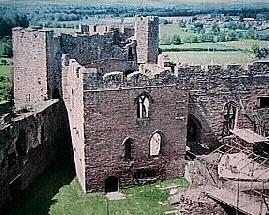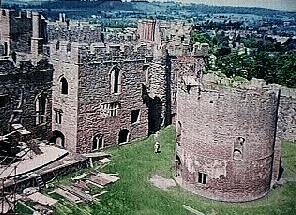Ludlow Castle
  |
Mighty Ludlow: an English castle on the Welsh Marches
  |
Mighty Ludlow: an English castle on the Welsh Marches
Ludlow Castle is first referred to by chroniclers in 1138, but its date of origin is not certain. The architecture suggests that the curtain wall of the inner bailey, its flanking towers and parts of the gatehouse-keep date from the late 11th century.
The site of Ludlow was in a corner of the important manor of Stanton, held since 1066 by the de Lacy family. The level building surface and the steep slopes to the north and west made this a fine defensive position. The rivers Teme and Corve gave further protection. Most of the castle was built of chunky Silurian limestone quarried from its own site. It was one of a line of Norman castles along the Marches, built to pacify the countryside and hold back the unconquered Welsh.
The de Lacys and their heirs retained the lordship until the late 13th century, but in the civil wars of King Stephen's reign it was held by their enemy, Joce de Dinan. In 1139 Stephen himself besieged the castle and showed great bravery by rescuing his ally, young Prince Henry of Scotland, from a grappling iron. The de Lacy's spent much of their time in Ireland, where they won great estates; but Ludlow remained a major power base. At times it was taken into royal hands, as in 1177 and afterwards, when the Pipe Rolls record regular payments 'to the keeper of Ludlow Castle'. Many meetings were held here, as in 1224, when Henry III made a treaty with the Welsh prince Llywelyn ap Iorwerth, with Archbishop Langton as mediator.
Right & below: Ludlow's famous Norman chapel with it's beautifully carved entrance.
When the last male de Lacy died about 1240, the family estates were divided between his two daughters. The castle eventually came into the possession of Geoffrey de Geneville, a French baron from Champagne who was a distant relative of Eleanor, queen to Edward I. Geoffrey spent most of his time in Ireland and in 1283 he gave his lands at Ludlow to his son Peter.
The refurbished castle made a useful base for Roger Mortimer of Wig more, who married a daughter of Peter de Geneville. He was the leader of a group of barons who dethroned the unpopular Edward II in 1326. Mortimer was created earl of March but he over-reached himself and was deposed and executed by rivals in 1330. Later the family regained power and royal favor and their activities brought Ludlow into the mainstream of national politics. The last male Mortimer died in 1425 but Ludlow castle passed to his sister's son Richard Plantagenet, Duke of York, who was the leader of the Yorkists in the War of the Roses. This affiliation brought new importance to Ludlow - but also resulted in the castle being taken and sacked by the rival Lancastrians in 1459.
When Edward IV, son of the Duke of York, became king in 1461, Ludlow Castle became Crown property. It remained a royal castle for the next 350 years except during the Civil War and the Commonwealth. In 1473 the king sent his son Edward to be brought up at Ludlow, away from the plagues and intrigues of London. The nobles and gentlemen who accompanied him formed a Prince's Council, under the presidency of Bishop Alcock, the prince's tutor. This council gradually assumed responsibility for the government of Wales and the border counties. Until the 1530s, however, its control was limited. The authority of this council, the Council of the Marches, increased after 1534, when Bishop Rowland Lee was appointed Lord President. The reorganization of Wales into shires with the infamous 'Acts of Union' was part of this process.
For more than a century Ludlow was virtually the capital of Wales and its courts were busy with criminal, ecclesiastical and civil cases. This resulted in much new building at the castle, especially in the 1550s and in 1581. The castle was now primarily a center for administration, though it also had many of the features of an Elizabethan stately home. The Council of the March was dissolved in 1641 but was revived with limited powers from 1660 until its abolition in 1689.
During the Civil War of 1642-46 Ludlow Castle was a Royalist stronghold. In 1646 the town and castle were besieged by a strong Parliamentary force under Colonel Birch. Though there was fighting on the outskirts of town and parts of the suburbs were burnt, the castle itself was surrendered after negotiation. The kind of demolition carried out elsewhere was therefore avoided. After 1669 the castle was quickly abandoned, as part of the policy of the new government of William and Mary, to centralize control of the whole of England and Wales in London. In 1722 Daniel Defoe described it as 'the very perfection of decay'.
The people of the town looted the castle for principal materials and rooms were soon roof-less. In the 1760s the government considered demolition, but in view of the costs involved, preferred to lease it in 1771 to the earl of Powis. A later earl bought the castle in 1811. Since 1811 the care of successive earls of Powis and their agents has arrested further decline, while in recent years grants from English Heritage have enabled important repair work to be done. Over 50,000 visitors now come to the castle each year.